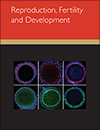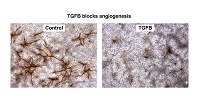Reproduction, Fertility and Development
Volume 33
Number 10 2021
The formation, growth and maturation of ovarian follicles, and the development of a healthy egg for fertilisation, are critical for reproduction in ruminants. This review presents a consensus of our current state of knowledge of those processes, including the effects of genes and environmental factors (especially nutrition). The entire process is considered, from the origin of primordial follicles before birth through to the ovulatory cycles that continue throughout the animal’s lifetime.
The growth of blood vessels, or angiogenesis, is critical to ovarian function, and therefore to the success of pregnancy. Angiogenesis is tightly controlled, and transforming growth factor-β1 (TGFB1), a potential regulatory factor, markedly inhibited angiogenesis in culture and altered cellular responses. Understanding how regulatory factors drive ovarian angiogenesis provides us with strategies to stimulate inadequate angiogenesis or to limit abnormal blood vessel growth.
Protein restriction may cause serious physiological damage, especially when it occurs in pregnant women, because pregnancy is a period of high nutritional demand. Therefore, we studied the effects of maternal chronic protein restriction on follicle development, demonstrating a negative effect on follicle activation and quality due to changes in follicle morphology. Protein deficiency may have deleterious effects on fertility, which may compromise the ability to establish successful future pregnancies.
An understanding of the biological mechanisms involved in determining cell fate during early embryo development is important for assisted reproductive technologies and has implications for stem cell biology. The aim of this study was to further our understanding of how cells in early bovine embryos may decide to become placenta or the embryo, and to compare our results with reports in mouse, the most studied animal model. In summary, bovine embryos have different features that reinforce them as another valuable model for mammalian and human embryo development.
More than 2300 genes are reportedly involved in spermatogenesis, but the functional roles of most genes in male fertility remain to be clarified. Family with sequence similarity 181 (Fam181) exhibits highly dynamic and specific expression in murine testis, suggesting an important role in spermatogenesis. Clustered regularly interspaced short palindromic repeat (CRISPR)/CRISPR-associated (Cas) 9 genome editing technology was used to generate Fam181a−/− mice. These mice did not exhibit discernible phenotypes. Moreover, Fam181a−/− mice had normal fertility and spermatogenesis, implying that Fam181a is dispensable for male fertility.
 , Robert A. Cushman, Joëlle Dupont, Stéphane Fabre
, Robert A. Cushman, Joëlle Dupont, Stéphane Fabre  , Richard G. Lea
, Richard G. Lea  , Graeme B. Martin, Francesca Mossa, Janet L. Pitman, Christopher A. Price and Peter Smith
, Graeme B. Martin, Francesca Mossa, Janet L. Pitman, Christopher A. Price and Peter Smith









